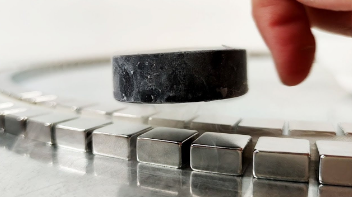Resistance is Futile: Superconductors
- Amanda Munandar
- Sep 29, 2024
- 3 min read
A superconductor is a material that can conduct electricity without any resistance when it's cooled to extremely low temperatures (Ginsberg, 2024). This lack of resistance means no energy is lost as heat, making it an absolute game-changer for technology and power transmission (Choi, 2023). Heat is the graveyard of energy, but superconductors cheat this death.
The first discovery of superconductivity happened in 1911 by Dutch physicist Heike Kamerlingh Onnes when he cooled mercury to around -269°C (4.2 K) and noticed it lost all electrical resistance. This means that electric current could flow through the material without any resistance or energy loss, allowing it to circulate indefinitely as long as the superconductor remains at its critical temperature and free from external disturbances. Onnes’ discovery earned him the Nobel Prize in Physics in 1913, and revealed a completely new property of metals (Ginsberg, 2024; Cornell Energy Systems Institute, 2020).
In a typical conductor, electrons (the charge carriers) move through a lattice of atoms. But it's not always smooth. Electrons bump into atoms, which makes them lose energy in the form of heat, creating resistance (Quantum Atlas, 2022). In superconductors, when cooled to their critical temperature (the temperature below which they become superconductors), electrons pair up into "Cooper pairs" and interact with the lattice differently, allowing them to travel without scattering and creating resistance (Quantum Atlas, 2022). Smooth ride.
Superconductors are what make MRI (Magnetic Resonance Imaging) machines possible. The strong magnetic fields created by superconducting magnets allow for detailed internal imaging of the body without invasive procedures (Quantum Atlas, 2022). Maglev trains also use superconducting magnets to lift and propel the train, significantly reducing friction and enabling speeds of over 483 km/hour (Choi, 2023). The trains float above the track and are pushed along by magnetic forces. This is possible due to the Meissner effect, leading to the complete expulsion of magnetic fields from the interior of the superconductor (Cornell Energy Systems Institute, 2020). On magnetic fields, superconductors float and levitate, and are both literally and metaphorically cool.
One of the most promising applications is in power transmission. Normally, a significant amount of electrical energy is lost when transmitted over long distances due to resistance in power lines. Superconductors could transmit electricity with zero loss, which would be highly efficient and could help reduce our reliance on fossil fuels (Choi, 2023).
Since the discovery of superconductors, scientists have been on an obsessive quest to find more materials that can become superconductive at higher, more practical temperatures. Such a breakthrough would lead to enormous advancements in technology, power grids, transportation, and more. In 2020, a team of researchers claimed to have found a room-temperature superconductor that works at 15°C (59°F), but the catch was it required extremely high pressure – about 267 gigapascals, which is roughly 2.6 million times atmospheric pressure, not ideal or practical for application (Cornell Energy Systems Institute, 2020). So, while we're getting closer, there's still a long way to go with the Maglev train.
Materials that exhibit superconductivity aren't limited to pure metals like mercury or lead. Metal alloys and compounds, and even ceramic or oxide-based compounds also act as superconductors at higher temperatures than pure metals. Of course, -196°C (77 K) cannot be considered a high temperature, but it is relatively high for superconductivity (Ginsberg, 2024). So, if you have a tub of liquid nitrogen lying around, you can chill a piece of ceramic down to this temperature and watch it turn it to a superconductor.
References
Choi, C. Q. (2023, May 12). Advancing grids with highway levitation. IEEE Spectrum. Retrieved September 21, 2024, from https://spectrum.ieee.org/maglev-superconducting-grid
First room-temperature superconductor excites — and baffles — scientists | Cornell Energy Systems Institute. (2020). Retrieved September 21, 2024, from https://energy.cornell.edu/news/first-room-temperature-superconductor-excites-and-baffles-scientists
Ginsberg, D. M. (2024, September 20). Superconductivity | Physics, Properties, & Applications. Encyclopedia Britannica. Retrieved September 21, 2024, from https://www.britannica.com/science/superconductivity
Krishnan, A. (2016, November 28). China plans first 600 km per hour maglev train line. India Today. Retrieved September 21, 2024, from https://www.indiatoday.in/world/story/china-first-600-km-per-hour-maglev-railway-354459-2016-11-28
Magnetic Games. (2021). Experiment at -196°C, Quantum Levitation | Magnetic Games [Video]. YouTube. Retrieved September 21, 2024, from https://www.youtube.com/watch?v=AWojYBhvfjM
Superconductors. (2022). Retrieved September 21, 2024, from https://quantumatlas.umd.edu/entry/superconductors/
Superconductivity | Applications of Quantum Mechanics. (2018). Retrieved September 21, 2024, from https://quantum.lassp.cornell.edu/lecture/superconductivity


Comments